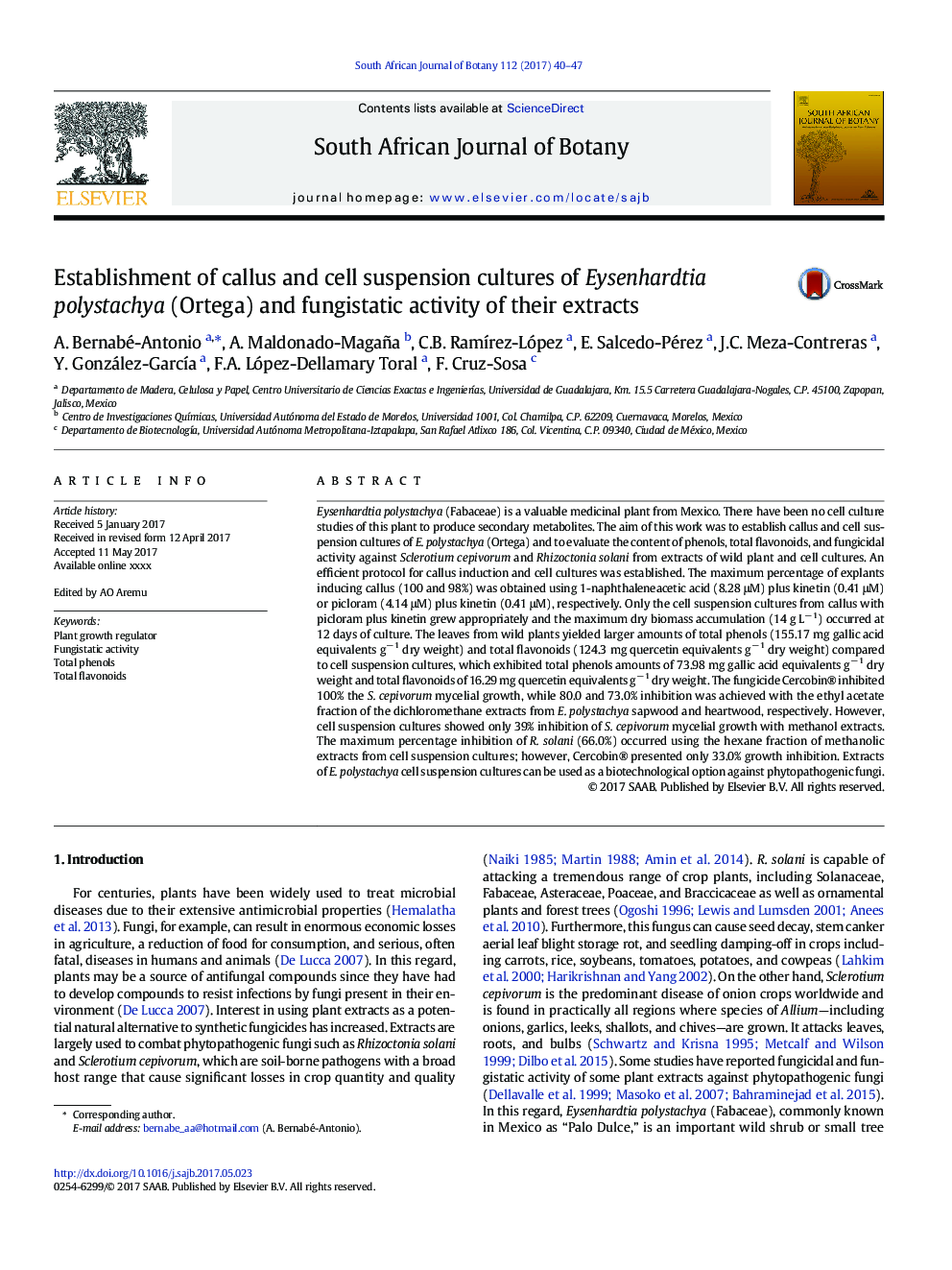| کد مقاله | کد نشریه | سال انتشار | مقاله انگلیسی | نسخه تمام متن |
|---|---|---|---|---|
| 5763162 | 1625146 | 2017 | 8 صفحه PDF | دانلود رایگان |
عنوان انگلیسی مقاله ISI
Establishment of callus and cell suspension cultures of Eysenhardtia polystachya (Ortega) and fungistatic activity of their extracts
دانلود مقاله + سفارش ترجمه
دانلود مقاله ISI انگلیسی
رایگان برای ایرانیان
کلمات کلیدی
موضوعات مرتبط
علوم زیستی و بیوفناوری
علوم کشاورزی و بیولوژیک
علوم زراعت و اصلاح نباتات
پیش نمایش صفحه اول مقاله

چکیده انگلیسی
Eysenhardtia polystachya (Fabaceae) is a valuable medicinal plant from Mexico. There have been no cell culture studies of this plant to produce secondary metabolites. The aim of this work was to establish callus and cell suspension cultures of E. polystachya (Ortega) and to evaluate the content of phenols, total flavonoids, and fungicidal activity against Sclerotium cepivorum and Rhizoctonia solani from extracts of wild plant and cell cultures. An efficient protocol for callus induction and cell cultures was established. The maximum percentage of explants inducing callus (100 and 98%) was obtained using 1-naphthaleneacetic acid (8.28 μM) plus kinetin (0.41 μM) or picloram (4.14 μM) plus kinetin (0.41 μM), respectively. Only the cell suspension cultures from callus with picloram plus kinetin grew appropriately and the maximum dry biomass accumulation (14 g Lâ 1) occurred at 12 days of culture. The leaves from wild plants yielded larger amounts of total phenols (155.17 mg gallic acid equivalents gâ 1 dry weight) and total flavonoids (124.3 mg quercetin equivalents gâ 1 dry weight) compared to cell suspension cultures, which exhibited total phenols amounts of 73.98 mg gallic acid equivalents gâ 1 dry weight and total flavonoids of 16.29 mg quercetin equivalents gâ 1 dry weight. The fungicide Cercobin® inhibited 100% the S. cepivorum mycelial growth, while 80.0 and 73.0% inhibition was achieved with the ethyl acetate fraction of the dichloromethane extracts from E. polystachya sapwood and heartwood, respectively. However, cell suspension cultures showed only 39% inhibition of S. cepivorum mycelial growth with methanol extracts. The maximum percentage inhibition of R. solani (66.0%) occurred using the hexane fraction of methanolic extracts from cell suspension cultures; however, Cercobin® presented only 33.0% growth inhibition. Extracts of E. polystachya cell suspension cultures can be used as a biotechnological option against phytopathogenic fungi.
ناشر
Database: Elsevier - ScienceDirect (ساینس دایرکت)
Journal: South African Journal of Botany - Volume 112, September 2017, Pages 40-47
Journal: South African Journal of Botany - Volume 112, September 2017, Pages 40-47
نویسندگان
A. Bernabé-Antonio, A. Maldonado-Magaña, C.B. RamÃrez-López, E. Salcedo-Pérez, J.C. Meza-Contreras, Y. González-GarcÃa, F.A. López-Dellamary Toral, F. Cruz-Sosa,